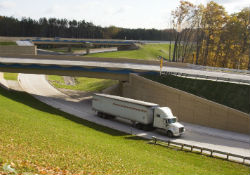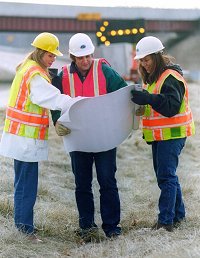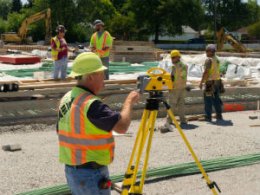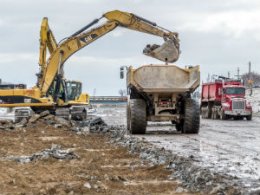
Construct a road
 Michigan is a national leader in road building; the state boasts the nation's first mile of rural concrete highway and many other landmark "firsts."
Michigan is a national leader in road building; the state boasts the nation's first mile of rural concrete highway and many other landmark "firsts."
PHASE I: Planning
MDOT collects and maintains a vast amount of information about our roads, including:Using this data, transportation planners, engineers, environmentalists, landscape architects, soil scientists and others identify trends that determine what and how to build. Other items to consider:
- Can MDOT acquire the property to build on?
- What are the environmental issues?
- What utilities will be affected by a project?
- How will we fund the project?
- How can this project be designed to be an asset to the community?
Money for road projects comes from gas taxes. Michigan drivers pay 19 cents per gallon in state taxes and 18.4 cents per gallon in federal gas tax. The tax on diesel fuel is 15 cents per gallon. The federal share of gas taxes is passed to the federal government, which distributes it through many programs. Until recently, Michigan received only 90.5 cents for every dollar in gas taxes sent to Washington. New legislation will increase Michigan's return from 90.5 cents to 92 cents on the dollar between 2005 and 2009.
 PHASE II: Design:
PHASE II: Design:
A survey of the area is step two. Recently, Global Positioning Systems, laser surveys, and other technology have sped up the process and improved accuracy. Many factors influence designs, including:
- location,
- terrain and soil properties,
- drainage capabilities,
- traffic volume,
- the ratio of cars to trucks and buses,
- possible future development in the area,
- effects on the environment or nearby residents.
With a design in hand, MDOT advertises for a contractor to do the actual building. MDOT awards contracts based on low bid price.
PHASE III: Earthwork
- First, the contractor builds embankments using cuts and fills.
 Next, a grader or bulldozer levels the screened dirt. Leveling bumps and filling in dips creates a surface that will support a road for decades.
Next, a grader or bulldozer levels the screened dirt. Leveling bumps and filling in dips creates a surface that will support a road for decades.- The screened dirt is sprayed with water and compacted to its maximum density.
- During this stage, the contactor installs drains and sewers. The center of the road must be higher than the edges so water will run off into the storm sewers. Drainage is a critical element because improper drainage will greatly reduce the new pavement's life expectancy.
- All of this work must pass strict inspections before the project can continue.
- To complete the earthwork, the contractor places gravel in 12-inch layers on the road bed. Workers moisten and compact each layer. Layers are added and compacted until the road bed reaches the height called for in the design.
 PHASE IV: Paving
PHASE IV: Paving
At last, the road bed is ready for paving. If the estimated paving cost is more than million, state law requires MDOT to conduct a life cycle cost analysis. In this analysis, planners and engineers study:
- the amount and type of traffic,
- the cost of paving material.
A formula that includes all these factors tells MDOT engineers to use either asphalt (bituminous) or concrete pavement.
- Asphalt uses bitumen, a petroleum product, to glue together sand and crushed rock. This mixture is heated to approximately 300 degrees at the asphalt plant. At the construction site, workers spread and compact the hot mixture onto the roadbed.
- Concrete uses cement and water as the glue between sand and crushed rock. Workers place concrete into steel molds called forms.
A finishing machine vibrates and trims it to the necessary height. To prevent cracks, workers cut joints between the concrete slabs. At each joint, wire baskets and steel dowels connect the slabs. These allow the slabs to expand and contract as the temperature changes. The slabs can slide from side to side along the dowels, but not up and down.
Modern paving equipment can insert dowels as the concrete is poured, then immediately tine the concrete.
PHASE V: Open to Traffic
With the new surface in place, MDOT orders ride quality testing. Testers use seismology equipment to measure vibrations of the new pavement. It there is too much vibration, the contractor must grind the pavement to ensure a smooth surface.
The final steps are:
- another drainage test,
- grading and landscaping around the pavement (where applicable),
- applying the permanent pavement markings.

















